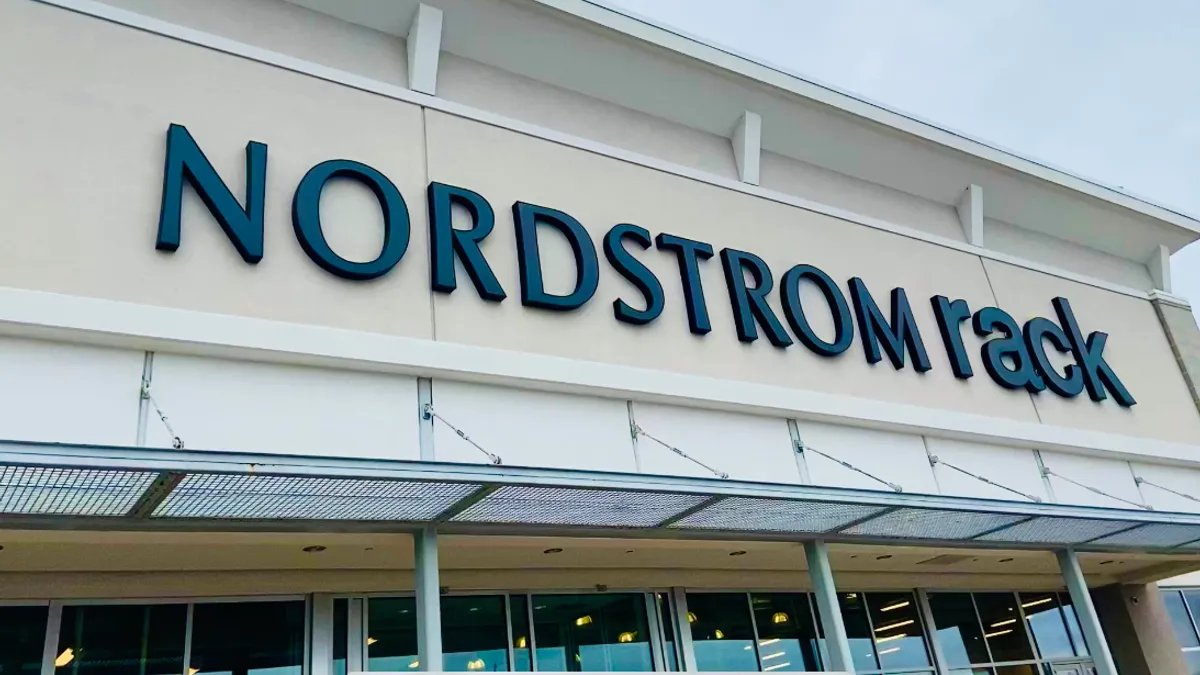Dive Brief:
-
Nordstrom on Tuesday said that third quarter net sales rose 18% year over year and fell 1% from 2019 to $3.5 billion. Digital sales fell 12% year over year but were up 20% compared to 2019, according to a company press release. Nordstrom doesn’t release comp sales.
-
Net sales at Nordstrom full-line stores rose 11% year over year and 3% from 2019, with the timing of the Anniversary Sale (in Q3 this year) contributing 300 basis points compared to 2019. Net sales at off-price Rack rose 35% year over year but fell 8% compared to 2019, the company said.
-
Net income rose 20.8% year over year. Gross profit, as a percentage of net sales, expanded by 230 basis points year over year and 80 basis points from 2019 to 35%.
Dive Insight:
Nordstrom's full-line stores returned to their pre-pandemic performance, CEO Erik Nordstrom told analysts on Tuesday. But its Rack stores are bumping up against inventory issues, in part because many premium brands are in short supply as they sell out at the full-line locations, he said.
An effort to expand the selection of budget goods at Rack, announced in February, doesn't appear to be panning out. The move, intended to widen Rack's customer base, instead lead to a 4% decline in average selling prices in the quarter "and put significant pressure" on its bottom line, according to a client note from Credit Suisse analyst Michael Binetti.
"We did bring and have brought more lower-priced product in over the year. Frankly, we went too far," Nordstrom said. "We brought some lower price product in categories that we've heard from customers is not what they're looking for."
The issues at Rack stand in sharp contrast to off-price rivals, which have largely been able to keep inventory in their stores and, in some cases, reported double-digit sales increases compared to 2019. Rack's weakness is hardly a new phenomenon, and was evident before the pandemic, according to analysts at GlobalData and William Blair.
"We believe management generally lacks credibility here after frequently speaking of strategic shifts to improve Rack’s trajectory as early as 2018, citing what seems to be consistent inventory and product mix challenges," William Blair analyst Dylan Carden said in emailed comments. The recent trend of brands wresting control of their own sales could impend Nordstrom's efforts to regroup, Carden warned.
Nordstrom's weakness is not just found in its off-price business, however. GlobalData noted that its full-line sales increases pale compared to rivals like Dillard's and Macy's during comparable periods, at a time of robust retail sales, something not fully explained by the slow return of tourism and downtown office workers. GlobalData Managing Director Neil Saunders pointed to disarray at many Nordstrom stores that could undermine its status as an upscale department store.
"While some of the issues are understandable because of inventory and supply chain snafus as well as labor shortages, Nordstrom is in danger of damaging its brand reputation unless it arrests some of the problems," he said in emailed comments. "In our view, it is very easy for stores to enter a negative spiral of decline from which they cannot escape. At present, Nordstrom is teetering on the edge of the whirlpool and risks being sucked in."
Cowen & Co. Managing Director Oliver Chen hailed several "green shoots" including strength in the Southern U.S., at suburban stores, in e-commerce and within the company's market strategy, which ties together its full-line, Rack and Local stores for online fulfillment and returns. But he joined others in noting Nordstrom's difficulty in digging out of its hole.
"We are cautious [Nordstrom] is losing shoppers and wallet share to better executing retailers, and looking ahead could see challenges winning shoppers back," he said in emailed comments.













